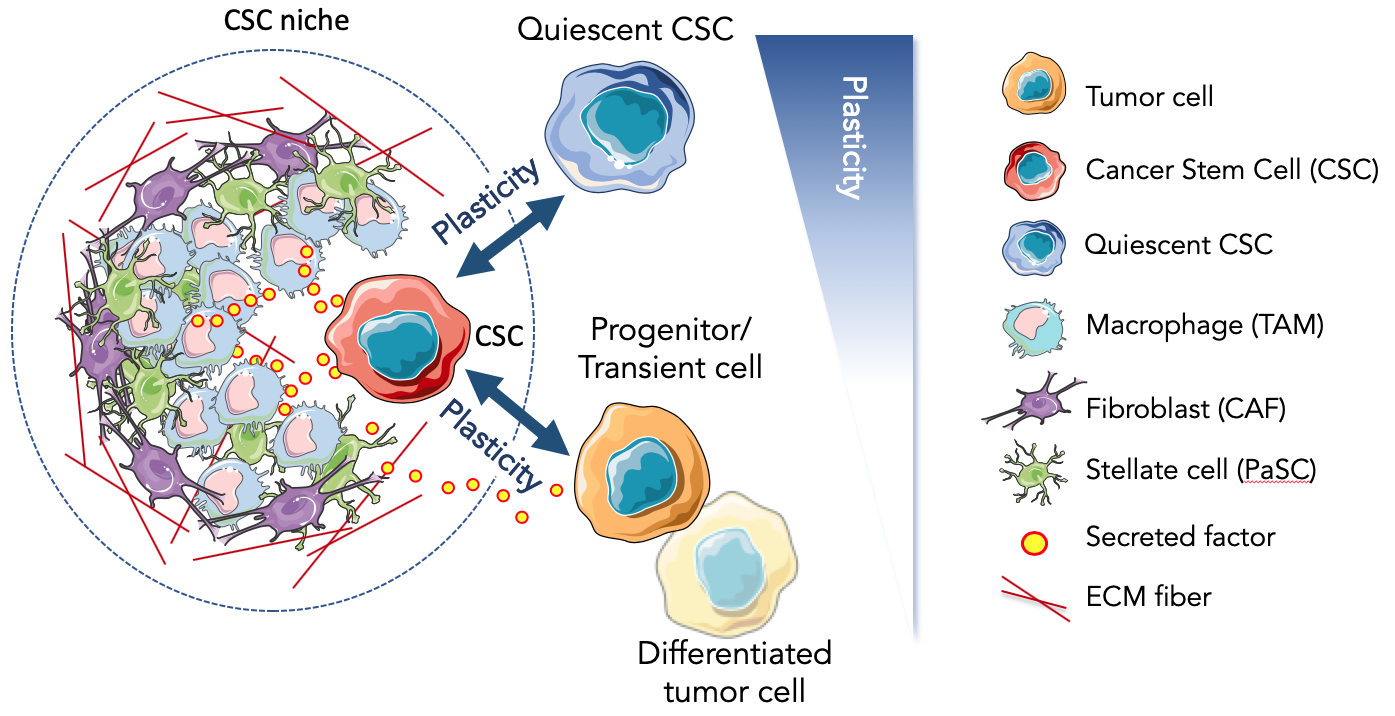CSC represent the root of the tumor, giving rise to all of the other tumor cells and driving intratumor heterogeneity. This subpopulation of cells have been shown to be exclusively tumorigenic, and highly metastatic and chemoresistant. Thus, from a clinical perspective, only elimination of the CSC will ensure tumor eradication.
By definition, CSCs are the sole source of tumor initiation, metastasis and cellular heterogeneity, giving rise to intermediate progenitors and terminally-differentiated bulk tumor cells. However, whether the CSC is a hardwired entity or a state has been a point of debate for the past 5 years.
 The Cancer Stem Cell (CSC) model. CSCs share phenotypes and characteristics of normal stem cells, such as unlimited self-renewal, which assures the survival of the CSC pool and supports the hierarchical model of tumor cell heterogeneity. CSCs also possess the capacity to divide symmetrically or asymmetrically, generating more CSCs or the multiple cell lineages present within the tumor bulk, including progenitor/transient cells and more differentiated tumor cells. The degrees of pluripotency, plasticity and chemoresistance are believed to correlate with the level of cellular differentiation and degree of heterogeneity. The less differentiated and heterogenous cells possesses more stem-like characteristics and are more plastic; however, progenitor/transient cells (and differentiated tumor cell to some degree) are also plastic under certain circumstances.
The Cancer Stem Cell (CSC) model. CSCs share phenotypes and characteristics of normal stem cells, such as unlimited self-renewal, which assures the survival of the CSC pool and supports the hierarchical model of tumor cell heterogeneity. CSCs also possess the capacity to divide symmetrically or asymmetrically, generating more CSCs or the multiple cell lineages present within the tumor bulk, including progenitor/transient cells and more differentiated tumor cells. The degrees of pluripotency, plasticity and chemoresistance are believed to correlate with the level of cellular differentiation and degree of heterogeneity. The less differentiated and heterogenous cells possesses more stem-like characteristics and are more plastic; however, progenitor/transient cells (and differentiated tumor cell to some degree) are also plastic under certain circumstances.
We now know that CSC-ness is not an intrinsic feature of a subpopulation of cells, but rather, CSC-ness is state governed and driven by temporal and spatial characteristics, and strongly influenced by the tumor microenvironment (TME). Thus only by targeting the CSC, the non-CSC transient cells and the TME will we succeed in curing cancer.

The CSC niche. CSCs are believed to reside in a niche within the TME. The niche is a smaller anatomically distinct and more specialized TME sub-compartment, which regulates CSC fate through cell-to-cell contacts or via cues from secreted niche milieu factors. Different CSC niches can exists, and dominate at any given time during the evolution of the tumor. If the CSC is lost, there is competition for other cells to reenter the niche to replace the CSC. This process, known as neutral competition in normal stem cell niches, is where stem cells progenies respond to extrinsic signaling factors and compete to occupy the niche. The same is believed to occur in tumors. Progenitor cells, transient cells and even “committed” differentiated tumor cells can undergo phenotypic transitions and transconvert into a CSC, a process known as cellular plasticity. In addition, it is likely that other CSCs (perhaps quiescent CSCs), can reoccupy the niche; however the degree of plasticity and capacity to undergo phenotypic transitions will likely determine what cell type can reenter the niche.